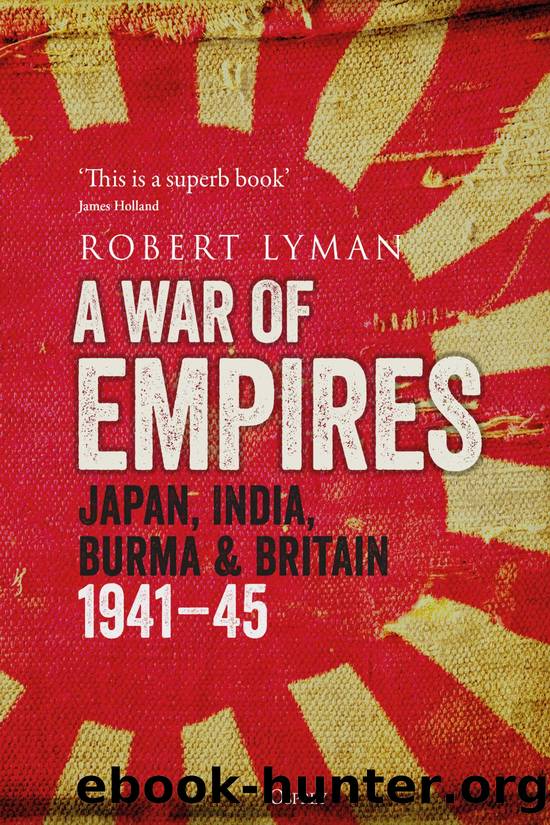A War of Empires: Japan, India, Burma & Britain: 1941â45 by Robert Lyman

Author:Robert Lyman [Lyman, Robert]
Language: eng
Format: epub
ISBN: 9781472847133
Google: WZUmEAAAQBAJ
Amazon: B091D73F5N
Published: 2021-11-11T00:00:00+00:00
24
Okeydoke
On the morning of 8 February 1944, the headlines of the Japanese-sponsored Greater Asia newspaper in Rangoon had trumpeted the end of the British in northern Arakan: âNippon Forces Launch Bold Offensive: Second Arakan Debacle Imminentâ. If somewhat premature, the newspaperâs claim nevertheless caught a measure of Japanese optimism about the prospects for Operation Ha-Go. Equally, it touched a raw nerve in British military sensibilities. Slimâs long-planned operation to retake Arakan by XV Corps, now commanded by Lieutenant General Philip Christison, had begun a month before. A British offensive in Arakan once the monsoon was over was essential to prevent any Japanese move against Chittagong, and initial operations by Harold Briggsâ 5 Indian Division and Frank Messervyâs 7 Indian Division in November and December 1943 had produced promising results. Coordinated battalion actions by both divisions resulted in a series of rapid lessons. Slim, Christison and the divisional commanders (5, 7, 26 and 81 West African) were determined to record and learn rapidly from their experience of combat. No reliance was to be placed on past doctrinal templates. If it didnât work, it was ditched. The lessons of the first two months of operations were:
1. The enemyâs positions were completely invisible to patrols and Observation Posts from the air.
2. The jungle was so thick that it sometimes took 8 hours to traverse one mile.
3. The best method of gaining contact was by leap-frogging companies from one prominent feature to another. These were preceded by fighting patrols which seized these features if empty and held them until the arrival of the company. Each patrol was accompanied by an artillery Forward Observer to assist them to do this.
4. At each advance the engineers had to bulldoze a central artery track on each battalion front for maintenance.
5. Once features were found held, battalions or companies were moved behind the enemy holding the feature so as to attack him from the rear and hold off reserves. This often led to heavy fighting but the enemy generally withdrew after a few days.
6. The divisional artillery was available and was brought down when called for by the leading company commander. Brigade and Battalion commanders had the regimental or battery commanders âin their pocketsâ. Each infantry company had an attached artillery observer to direct the guns.1
The initial success in forcing a measure of withdrawal against the Japanese gave Briggs and Messervy hope that a strong attack against the Tunnels area would do likewise. Operation Cudgel comprised an advance to the Japanese-held MaungdawâButhidaung Road across the Mayu Hills by 5 and 7 Indian Divisions; a long-range penetration operation against the enemyâs right flank deep in the Kaladan Valley â relying on porters and air supply â by 81 West African Division; and an amphibious assault against Akyab by 36 Division (Operation Bulldozer). Briggsâ 5 and Messervyâs 7 Indian Divisions were to capture the defensive line the Japanese had built during the monsoon, a formidable barrier of defensive positions stretching across 16 miles of the Mayu Range, grandly named the
Download
This site does not store any files on its server. We only index and link to content provided by other sites. Please contact the content providers to delete copyright contents if any and email us, we'll remove relevant links or contents immediately.
What's Done in Darkness by Kayla Perrin(25516)
Shot Through the Heart: DI Grace Fisher 2 by Isabelle Grey(18237)
Shot Through the Heart by Mercy Celeste(18180)
The Fifty Shades Trilogy & Grey by E L James(17792)
The 3rd Cycle of the Betrayed Series Collection: Extremely Controversial Historical Thrillers (Betrayed Series Boxed set) by McCray Carolyn(13206)
The Subtle Art of Not Giving a F*ck by Mark Manson(12934)
Scorched Earth by Nick Kyme(11856)
Stepbrother Stories 2 - 21 Taboo Story Collection (Brother Sister Stepbrother Stepsister Taboo Pseudo Incest Family Virgin Creampie Pregnant Forced Pregnancy Breeding) by Roxi Harding(11079)
Drei Generationen auf dem Jakobsweg by Stein Pia(10232)
Suna by Ziefle Pia(10197)
Scythe by Neal Shusterman(9284)
International Relations from the Global South; Worlds of Difference; First Edition by Arlene B. Tickner & Karen Smith(8637)
Successful Proposal Strategies for Small Businesses: Using Knowledge Management ot Win Govenment, Private Sector, and International Contracts 3rd Edition by Robert Frey(8437)
This is Going to Hurt by Adam Kay(7722)
Dirty Filthy Fix: A Fixed Trilogy Novella by Laurelin Paige(6469)
He Loves Me...KNOT by RC Boldt(5821)
How to Make Love to a Negro Without Getting Tired by Dany LaFerrière(5406)
Interdimensional Brothel by F4U(5320)
Thankful For Her by Alexa Riley(5184)
